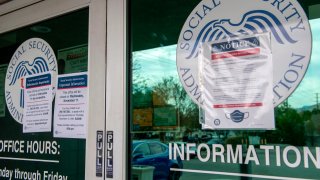
- The onset of the Covid-19 pandemic prompted new fears about Social Security's trust funds and benefits.
- More than a year into the pandemic, some of those concerns have abated as the U.S. economy has rebounded.
- One age cohort is not expected to take as big a benefit cut. Meanwhile, all beneficiaries could be poised for a higher cost-of-living adjustment next year.

When the onset of the Covid-19 pandemic sent shock waves through the U.S. economy, its also prompted worries about how the ensuing downturn could affect Social Security.
The program's trust funds were already running low. At the same time, the Social Security Administration was faced with the unprecedented task of moving its in-person services to mostly mail only.
Get Southern California news, weather forecasts and entertainment stories to your inbox. Sign up for NBC LA newsletters.
Now, in the aftermath of those initial shocks, some fears of disproportionately large hits to the program's trust funds or benefits have proven to be unfounded.
Meanwhile, the government agency's services and cost-of-living adjustment for next year could be poised for changes.
Here's what we now know about how the pandemic has affected Social Security.
Social Security's trust funds still running low

Social Security's trust funds were already running low when Covid-19 hit.
Money Report
In April 2020, the Social Security Administration said in its annual projections that the estimated depletion dates remained the same. The Old-Age and Survivors Insurance Trust Fund, which disburses retirement benefits, was projected to become depleted in 2034, at which point 76% of promised benefits would be payable. When combined with the Disability Insurance fund, both sets of reserves were expected to become depleted in 2035, with 79% of promised benefits payable at that time.
But those estimates did not account for Covid-19. The economic downturn fueled some fears those depletion dates could be accelerated.
The economic downturn could have prompted the retirement fund's depletion date to move up to between 2029 to 2033, based on estimates from the Bipartisan Policy Center, done last year. Estimates from the Congressional Budget Office from earlier this year indicate that the trust fund could be exhausted in 2032, with the disability fund running out in 2035.
The annual Social Security Administration trustees report for this year has yet to be released with post-Covid-19 estimates.
But because the economy is growing, including middle- and upper-income payrolls that comprise most of the trust funds' revenues, the pandemic's impact could be small, according to Shai Akabas, director of economic policy at the Bipartisan Policy Center.
"The bottom line is that we don't think the picture has changed a whole lot," Akabas said. "It's still the dire picture that we had a year or two years or three years ago."
Those born in 1960 may get a benefit cut
The dramatic effect the pandemic had on the economy and employment in 2020 had some worrying that the average wage index could drop dramatically.
That, in turn, could lower Social Security benefits for those people whose benefits are calculated based on that year, particularly retirement benefits for people born in 1960.
The average wage index has increased every year from 1951 to 2008, then declined by 1.5% in 2009, due the Great Recession, Social Security Chief Actuary Stephen Goss said last year. In 2020, a "much larger decline" was possible, he said.
If the average wage index were to fall 5.9% from 2019, that would reduce the monthly retirement benefit for a median earner born in 1960 by about $119 per month, he said at the time.
More from Personal Finance:
Retired and returning to work: How your income may clash with other finances
Who would benefit from proposed changes to 401(k) catch-up contributions
Inflation concerns have many retirees worried about running out of money
But the good news is that as 2020 progressed, the average wage index does not appear to have dropped by as much as people had anticipated.
The Congressional Budget Office estimated in January that it may have fallen just 0.5%. The official average wage index for 2020 won't be confirmed until later this year.
The recovery points to a much smaller drop in benefits for the cohort affected.
If that holds true, those beneficiaries will not see such a steep benefit reduction, Akabas said.
Moreover, it's unlikely there will be imminent Congressional action on the issue, though there should probably be a floor put in place to prevent those kinds of outcomes from happening in the future, he said.
Social Security offices still have a mail backlog
In March 2020, the Social Security Administration suspended in-person services at its field and hearings offices due to the pandemic.
Today, in-person appointments are available on a limited basis. However, to get a time slot, your needs must be critical, such as if your issue is interfering with your ability to access food, shelter or medical care.
Other transactions – like benefits applications and requests for card replacements – have instead been executed by mail.
But like the IRS, which has a backlog of millions of unprocessed paper tax returns, the Social Security Administration is also behind on its mail.
A recent investigation by the Social Security Office of the Inspector General found that the administration has "inadequate internal controls over mail processing."
That was after the Office of the Inspector General visited 73 locations, including field offices, program service centers and Social Security card centers and found a widespread backlog of unprocessed applications and inefficient processing procedures.
The Office of the Inspector General is working with the Social Security Administration to address those issues, with a final report expected before the end of this year.
Next year's COLA could be much higher

Social Security's annual cost-of-living adjustment is calculated each year based on the Consumer Price Index for Urban Wage Earners and Clerical Workers, or CPI-W.
Benefits went up by 1.3% in 2021, giving about 70 million Americans a boost to their Social Security or Supplemental Security Income benefits.
For 2022, that adjustment is shaping up to be potentially much bigger for one reason: rising inflation.
Higher prices on everything from food to gasoline has helped push the latest estimate for next year to 6.1%, according to The Senior Citizens League, a nonpartisan senior group.
If the annual bump reaches that level, it would be the largest increase since 1983.
However, there is still three more months' of data to come in before the Social Security Administration announces the official rate change for next year.






